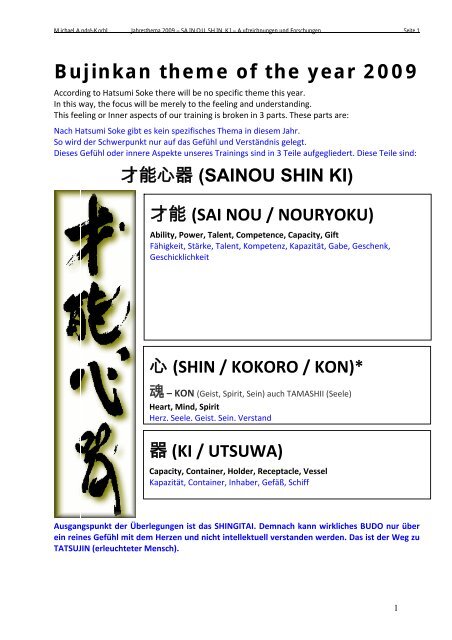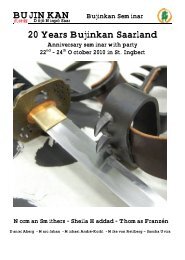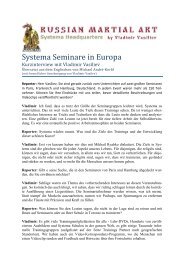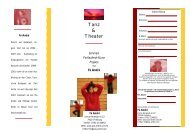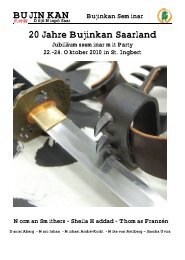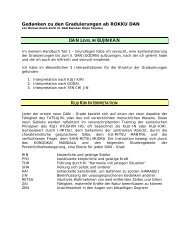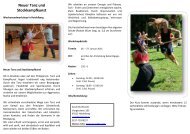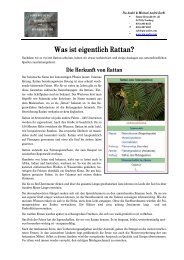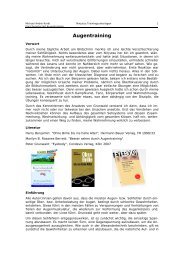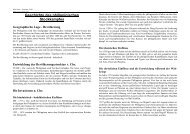Bujinkan theme of the year 2009 - Pia André
Bujinkan theme of the year 2009 - Pia André
Bujinkan theme of the year 2009 - Pia André
You also want an ePaper? Increase the reach of your titles
YUMPU automatically turns print PDFs into web optimized ePapers that Google loves.
Michael André-Korbl Jahres<strong>the</strong>ma <strong>2009</strong> — SAINOU SHIN KI — Aufzeichnungen und Forschungen Seite 1<strong>Bujinkan</strong> <strong><strong>the</strong>me</strong> <strong>of</strong> <strong>the</strong> <strong>year</strong> <strong>2009</strong>According to Hatsumi Soke <strong>the</strong>re will be no specific <strong><strong>the</strong>me</strong> this <strong>year</strong>.In this way, <strong>the</strong> focus will be merely to <strong>the</strong> feeling and understanding.This feeling or Inner aspects <strong>of</strong> our training is broken in 3 parts. These parts are:Nach Hatsumi Soke gibt es kein spezifisches Thema in diesem Jahr.So wird der Schwerpunkt nur auf das Gefühl und Verständnis gelegt.Dieses Gefühl oder innere Aspekte unseres Trainings sind in 3 Teile aufgegliedert. Diese Teile sind:才 能 心 器 (SAINOU SHIN KI)才 能 (SAI NOU / NOURYOKU)Ability, Power, Talent, Competence, Capacity, GiftFähigkeit, Stärke, Talent, Kompetenz, Kapazität, Gabe, Geschenk,Geschicklichkeit心 (SHIN / KOKORO / KON)* – KON (Geist, Spirit, Sein) auch TAMASHII (Seele)Heart, Mind, SpiritHerz, Seele, Geist, Sein, Verstand器 (KI / UTSUWA)Capacity, Container, Holder, Receptacle, VesselKapazität, Container, Inhaber, Gefäß, SchiffAusgangspunkt der Überlegungen ist das SHINGITAI. Demnach kann wirkliches BUDO nur überein reines Gefühl mit dem Herzen und nicht intellektuell verstanden werden. Das ist der Weg zuTATSUJIN (erleuchteter Mensch).1
Michael André-Korbl Jahres<strong>the</strong>ma <strong>2009</strong> — SAINOU SHIN KI — Aufzeichnungen und Forschungen Seite 2Jahres<strong>the</strong>ma <strong>2009</strong>Hatsumi gab für dieses Jahr kein spezielles Thema vor.Das Studium im letzten Jahr umfasste den Bereich der Techniken und Prinzipien: OMOTEDieses Jahr wenden wir uns der Betrachtung des inneren Bereichs des Individuums in denverschiedenen Schulen zu: URAHatsumi Sensei führt hier das SHINGITAI an: „BUDO kann nicht rationell mit dem Kopf verstandenwerden, sondern nur über ein reines Gefühl mit dem Herzen.“Deshalb die Dreigliederung der Persönlichkeit in Talent SAINŌ / NŌRYOKU, <strong>of</strong>fenes Herz SHIN /KOKORO / KON und Kapazität / Persönlichkeit KI / UTSUWA, auch als SANSHIN zu verstehen.Das Verständnis ist nicht so leicht. Die Schüler sollen sich an Lehrer wenden, welche diesesverstanden haben und die Grundlagen von SAINOU, KOKORO und UTSUWA verkörpern undweitergeben können.Auf der Grundlage der Beherrschung des TAIJUTSU, beginnt das Studium des NINPO.NINPO überschreitet den rein kämpferischen Aspekt BUMON und lehrt auch den spirituellen WegSHUMON.Die Wurzeln unserer Kriegskunst liegen auch im SHUGENDO, eine Mischung aus dem esoterischenBuddhismus SHINGON und TENDAI MIKKYO und dem SHINTOISMUS.SOKE hat im Laufe des Jahres das zweite KANJI öfter verändert und jeweils andere Bedeutungenbetont. Er hat später SAINOU KON KI benutzt, weil er registrierte, dass sich die Studentenentwickelt und an ihrem Herz gearbeitet haben. Er hat den Level von „Herz“ auf „Spirit“gehoben.2
Michael André-Korbl Jahres<strong>the</strong>ma <strong>2009</strong> — SAINOU SHIN KI — Aufzeichnungen und Forschungen Seite 3Thoughts on Sainou Shin KiGedanken zu Sainou Shin Ki<strong>Bujinkan</strong> <strong><strong>the</strong>me</strong> <strong>of</strong> <strong>the</strong> <strong>year</strong><strong>2009</strong>才 能 心 器 (SAINOU SHIN KI)The first and second Kanji toge<strong>the</strong>r can read Sainou. This translates as talent, a gift, or ability. Itcan also mean knack, as in ”he has a knack for music.” (er hat ein Talent für Musik)The third Kanji, reads Shin. As I stated in my last page, it can also read kokoro. However, in thiscombination <strong>of</strong> kanji, it is more commonly referred to as Shin (heart, spirit, mind).The fourth Kanji reads KI. This is <strong>the</strong> same kanji as Utsuwa. However, in this combination it readsas KI, and means caliber, capability or capacity.To my knowledge, this is <strong>the</strong> first time he has written this concept telling <strong>of</strong> <strong>the</strong> direction or focus<strong>of</strong> next <strong>year</strong>s training.Soke stated to me” This is very important for <strong>the</strong> budoka”.Eventhough Soke gives us a particular concept or <strong><strong>the</strong>me</strong> to base <strong>the</strong> training on each <strong>year</strong>, italways becomes transparent. Why? I feel <strong>the</strong> lessons are all found within <strong>the</strong> kukan. The gokui <strong>of</strong>budo. There are differences in each <strong>year</strong>’s <strong><strong>the</strong>me</strong>, yet <strong>the</strong>se slight differences can only be seen bythose who are at <strong>the</strong> level <strong>of</strong> training to absorb <strong>the</strong>m. This is important to understand.We all stand in <strong>the</strong> same room toge<strong>the</strong>r. At times, we stand alongside Sokes Shihan. Toge<strong>the</strong>r welisten to Sokes words. Is your ability, heart and overall capacity at <strong>the</strong> level <strong>of</strong> maturity to absorbexactly <strong>the</strong> same lessons as <strong>the</strong> Shihan? I doubt it. We all interpret <strong>the</strong> training from our currentability and capacity. I would like to say to those who feel that <strong>the</strong>y know it, that <strong>the</strong>y are in a state<strong>of</strong> delusion. You can never know it. Why? Because you are forever evolving. Our knowledge,thinking, ways <strong>of</strong> doing things etc, always change. It’s ignorant to make judgements and trulybelieve you know “<strong>the</strong> way it is”. If you do, you have become obstinate in a sense. And this issomething that <strong>the</strong> code <strong>of</strong> <strong>the</strong> dojo asks practitioners not to be imprisoned by. People hide well.People hide <strong>the</strong>mselves by giving <strong>the</strong> sense that <strong>the</strong>y know, or even don’t know. They adaptaccording to <strong>the</strong> people <strong>the</strong>y associate with. This is trickery. But this trickery is based frominsecurity. The most important thing is to remain yourself. By this I mean having <strong>the</strong> strength tostand alone. If you make people feel uneasy from maintaining your truth, is this your problem? It’simportant to veto words <strong>of</strong> o<strong>the</strong>rs and also disagree once in a while with friends. To accepteverything, or even let things go, is sometimes not appropriate. You have to discern and make <strong>the</strong>choice to return what was given, or just take it.Life is about speaking your truth.Duncan Stewart3
Michael André-Korbl Jahres<strong>the</strong>ma <strong>2009</strong> — SAINOU SHIN KI — Aufzeichnungen und Forschungen Seite 4Das erste und zweite Kanji kann man zusammen lesen als SAINOU. Dies wird übersetzt als Talent,Geschenk, oder Fähigkeit. Es kann auch bedeuten, Talent, wie in "er hat ein Talent für Musik."Das dritte Kanji, liest man als SHIN. Wie ich in meiner letzten Seite bemerkte, kann es auch alsKOKORO gelesen werden. Allerdings, in dieser Kombination von Kanji, ist es gemeinhin als SHINbekannt (Herz, Geist, Verstand).Das vierte Kanji liest man als KI. Dies ist das gleiche wie Kanji UTSUWA. Allerdings, in dieserKombination lautet es KI, und bedeutet: Kaliber, Fähigkeit oder Kapazität.Meines Wissens ist es das erste Mal dass er dieses Konzept als Leitung oder Schwerpunkt derAusbildung im nächsten Jahr geschrieben hat.Soke erklärte mir: "Dies ist sehr wichtig für die Budoka".Trotz dass Soke uns einen bestimmten Begriff oder Thema als Grundlage des Trainings für jedesJahr gibt, wird es immer transparent. Warum? Ich glaube, die Lehren sind alle innerhalb derKUKAN. Die GOKUI des BUDO. Es gibt Unterschiede in den Themen jedes Jahres, aber dieseleichten Unterschiede können nur von denjenigen gesehen werden, die auf der Ebene desTrainings sind, um sie zu absorbieren. Dies ist wichtig zu verstehen.Wir alle stehen in demselben Raum zusammen. In Zeiten stehen wir neben Sokes Shihanen.Gemeinsam hören wir Sokes Worte. Sind eure Fähigkeit, eurer Herz und eure gesamte Kapazitätauf der Ebene der Reife, um genau die gleichen Lektionen, wie die Shihan aufzunehmen? Ich habeda meine Zweifel. Wir interpretieren das Training mit unseren aktuellen Fähigkeiten undKapazitäten. Ich möchte sagen, diejenigen, die glauben, dass sie es wissen, befinden sich in einemZustand der Täuschung. Man kann nie endgültig wissen. Warum? Weil Du Dich immer weiterentwickelst. Unser Wissen, Denken, Wege, Dinge zu tun, usw. ändern sich jederzeit. Es istignorant, zu urteilen und wirklich zu glauben, dass man weiß, "wie sie geht". Wenn Du das tust, ineinem gewissen Sinne stur geworden. Und das ist etwas, das der Code des Dojo vom Übendenfordert sich nicht dadurch gefangen nehmen zu lassen. Menschen verstecken sich gut. DieMenschen verstecken sich, indem sie vorgeben, dass sie wissen, oder sogar nicht wissen. Sie passensich den Menschen an, mit denen sie verbunden sind. Aber diese Tricks basieren auf Unsicherheit.Das Wichtigste ist, dass man selbst bleibt. Damit meine ich, die Stärke zu besitzen, allein für sichzu stehen. Wenn Du den Menschen ein ungutes Gefühl gibst, wenn Du bei der Wahrheit bleibst, istdas Dein Problem? Es ist wichtig, anderen zu widersprechen oder anderer Meinung mit seinenFreunden zu sein. Alles zu akzeptieren, oder sogar die Dinge loszulassen, ist manchmal nichtangemessen. Du hast, zu erkennen und die Wahl zu treffen, um wieder etwas zu entgegnen, oder esnur hinzunehmen.Das Leben bedeutet, Deine Wahrheit zu vertreten.Duncan Stewart4
Michael André-Korbl Jahres<strong>the</strong>ma <strong>2009</strong> — SAINOU SHIN KI — Aufzeichnungen und Forschungen Seite 5It seems that Soke hinted <strong>the</strong> <strong><strong>the</strong>me</strong> for <strong>the</strong> following <strong>year</strong> last Sunday atHonbu. However, it is still unclear exactly (as always). Soke mentioned<strong>the</strong> following words to contemplate. The translators did well on <strong>the</strong> spot topass to us all what Soke was trying to say.life ?It was mentioned that <strong>the</strong>se three points are crucial for development in <strong>the</strong>martial ways and also life in general. We can observe <strong>the</strong>m as having arelationship with Shin Gi Tai and Sanshin as well. Soke has alwaysmentioned that <strong>the</strong> controlling / knowing / or utilising <strong>of</strong> three points isnecessary to maintain control over your opponent and in turn your life.However, in regards to <strong>the</strong> following, we can maybe think and view <strong>the</strong>points below as <strong>the</strong> three essentials for knowing <strong>the</strong> secrets to a happyNouryoku - this is translated as ability, power, talent, competence or capacity.Kokoro - kokoro is generally translated as heart, but can also mean mind or spirit.Utsuwa - translates generally as a container, holder, receptacle or vessel. However, according to <strong>the</strong>dictionary, it can also relate to caliber, capacity, or a person <strong>of</strong> high/low caliber.I think if we view <strong>the</strong>se points as entities to teach us <strong>the</strong> truth <strong>of</strong> truly living life to <strong>the</strong> fullest, wecan appreciate that <strong>the</strong> three must be unified (shin gi tai ichi) in order to become a tatsujin.Harmonious and positive unification <strong>of</strong> <strong>the</strong> three is crucial. The person may be in <strong>the</strong> best position,but have a bad heart. Thus <strong>the</strong>y will only be able to reach a certain capacity and have little power, ortrue capability. We can have a large amount <strong>of</strong> ability and a great heart, but not be in <strong>the</strong> correctenvironment (utsuwa) to fully develop our true / innate potential. We must be able to unify <strong>the</strong> threeto fully express our true capacity and power in life. It’s no use being meek and mild and notexpressing oneself. This is a sickness and hinders ones true potential. Many people have <strong>the</strong>senecessary traits to fully achieve <strong>the</strong>ir true potential. However, <strong>the</strong>y are unable to tread <strong>the</strong> right pathor feel for <strong>the</strong> right way due to an in balance in <strong>of</strong> <strong>the</strong> three components.As budoka, it seems Soke wants us to delve deeper and encourage everyone to find <strong>the</strong> truth <strong>of</strong> <strong>the</strong>irlives and follow <strong>the</strong> direction chosen by <strong>the</strong> Gods. It’s <strong>of</strong>ten that we meet wonderfully talentedpeople who have progressed naturally but do not continue to reach <strong>the</strong>ir full potential. Many peoplerely on <strong>the</strong>ir natural talent. This will only get <strong>the</strong>m so far. It’s important to understand this andforever research and learn new things. We as friends try to support our gifted friends by givingpraise and advice on what WE see as needed for <strong>the</strong>m to reach <strong>the</strong>ir true potential. However, wecannot make people do things. There is a saying. ” You can lead a horse to water but you cannotmake it drink.” It all depends on <strong>the</strong> person. It depends on how thirsty <strong>the</strong>y are for real growth anddevelopment as a human being. Also, this topic may help us appreciate <strong>the</strong> story about <strong>the</strong> big fishin <strong>the</strong> little pond. Both goldfish and plants are greatly affected by <strong>the</strong> environment in which <strong>the</strong>ylive. E.g.: fish bowl or pot. If we increase <strong>the</strong> size, we can influence change, and <strong>the</strong>y are able toexpand and experience more, gaining a greater capacity.Soke also mentioned at one Taikai that <strong>the</strong>re are people <strong>of</strong> varied qualities and <strong>the</strong>refore influencedifferent people in different ways. Some <strong>of</strong> <strong>the</strong>se people will naturally grow into large trees, andsome will only become small trees. This does not mean that <strong>the</strong> large ones will become <strong>the</strong> best and<strong>the</strong> small ones will have no influence. It just means that everyone has a capacity. Some people havea larger capacity than o<strong>the</strong>rs, but <strong>the</strong> affect <strong>the</strong>y have on <strong>the</strong>ir students is no different to <strong>the</strong> teachers5
Michael André-Korbl Jahres<strong>the</strong>ma <strong>2009</strong> — SAINOU SHIN KI — Aufzeichnungen und Forschungen Seite 6with a smaller capacity. We attract those who can relate to us. The connection is <strong>the</strong> most importantthing.We can stand and wonder at <strong>the</strong> Californian Redwoods that grow to 90 feet, or stand and wonder aswe look down at <strong>the</strong> beautiful bonzai that grow proudly at our feet. It’s <strong>the</strong> same.Soke has said that ”<strong>the</strong> larger capacity you have, <strong>the</strong> more you can accept.” I think we can relate<strong>the</strong>se words to nouryoku kokoro utsuwa.For me, what is important is to trust ones inner self and learn <strong>the</strong> art <strong>of</strong> discernment. That is, wemust “know” and “see” instinctively what is good for us and make a decision that will truly assistin developing ourselves fur<strong>the</strong>r as a budoka and a complete human being.Gambarimashou!Duncan StewartToday, Soke talked about 3 things which are important for a martial artist. These 3 things may bethought <strong>of</strong> as a kind <strong>of</strong> 'Sanshin'. He said that <strong>the</strong>se things were going to become a bit <strong>of</strong> a <strong><strong>the</strong>me</strong> fornext <strong>year</strong>.They are:1) Sainou (Ability/talent)2) Kokoro (Heart)3) Utsuwa (Capacity)While <strong>the</strong> first 2 are quite clear, <strong>the</strong> third one deserves a little attention and clarification.The main meaning <strong>of</strong> <strong>the</strong> word 'utsuwa', its first definition in <strong>the</strong> dictionary, is'container/receptacle/vessel'. A secondary meaning, however, is concerning a person's capacity orpotential. My dictionary has <strong>the</strong> examples <strong>of</strong>:"Utsuwa no ookii." (a person <strong>of</strong> high caliber)."Daitouryou ni naru utsuwa dewa nai." (He [doesn't have what it takes / isn't cut out] to bepresident. / He is not <strong>of</strong> presidential caliber [stature])So utsuwa can mean 'caliber', to have 'potential', basically to have <strong>the</strong> 'right stuff'.But if we look at <strong>the</strong> basic meaning again - 'container', we can take it in an interesting direction.Fish, plants etc. will only grow to <strong>the</strong> size <strong>of</strong> <strong>the</strong> container which <strong>the</strong>y are in. Their growth islimited by <strong>the</strong> size <strong>of</strong> <strong>the</strong>ir container. Humans too have a 'limit' to <strong>the</strong>ir potential. If <strong>the</strong>ir utsuwa issmall, <strong>the</strong>y can never grow bigger than its limits. Having a large utsuwa/capacity is maybe whatSoke is trying to say.So, ability, heart and a capacity for growth is important for a martial artist. That is how Iinterpret what he was talking about today.Mark Lithgow6
Michael André-Korbl Jahres<strong>the</strong>ma <strong>2009</strong> — SAINOU SHIN KI — Aufzeichnungen und Forschungen Seite 7BUJIN MARISHITEN [Goddess <strong>of</strong> War, The Goddess and Patroness <strong>of</strong> <strong>the</strong> Samurai]Bujin Marishiten is a fairly obscure goddess that was originally adeity <strong>of</strong> Indian/Chinese Buddhism, until she was brought over toJapan. There, she was adopted by <strong>the</strong> warrior class <strong>of</strong> Samurai as<strong>the</strong>ir patroness and protectress. She is known by many differentnames and for many different aspects, including but not limited to:Marici (Sanskrit), Marisha-Ten (ano<strong>the</strong>r Japanese name) , andMolichitian (Chinese). Marishiten was adopted as <strong>the</strong> patroness <strong>of</strong><strong>the</strong> Warrior class in <strong>the</strong> 8th century and was considered so for 900<strong>year</strong>s after.The reverence <strong>of</strong> Marishiten seemed to stem from <strong>the</strong> “cult <strong>of</strong> <strong>the</strong>Marici”. Marici is <strong>the</strong> Buddhist goddess <strong>of</strong> light whose Hinducounterpart is Surya, <strong>the</strong> Sun God. She is <strong>of</strong>ten referred to as <strong>the</strong>“Diamond Sow” and is depicted riding a lotus which is driven by 7-9boars (depending on <strong>the</strong> resource), with weapons in her 6 hands.By worshipping Marishiten, <strong>the</strong> samurai believed that a warriorwould transcend into a more rarified spiritual realm, which is <strong>of</strong>tenassociated with <strong>the</strong> practice <strong>of</strong> Zen. Strangely, however, <strong>the</strong>worship <strong>of</strong> Marishiten predates any o<strong>the</strong>r documentation <strong>of</strong> ZenBuddhism.So, what exactly did Marishiten do for <strong>the</strong> samurai? By worshipping her, a warrior would reach aspiritual level that was not concerned with winning or losing, nor with life or death. Bytranscending to this level, <strong>the</strong> warrior was so empowered by this goddess, that he was nolonger imprisoned by his own grasp on life. He was able to let go to his mortality and become abetter warrior. In <strong>the</strong> worship <strong>of</strong> Marishiten, <strong>the</strong> warrior reached an ultimate act <strong>of</strong> selflessness.The cult <strong>of</strong> <strong>the</strong> Marishiten, according to Dr. Hatsumi Sensei, provided a way to achieveselflessness and compassion through Buddhist training by incorporating a passion for <strong>the</strong>mastery <strong>of</strong> <strong>the</strong> self.Ritual <strong>of</strong> <strong>the</strong> Warrior Goddess – Warrior DedicationPrepare ritual space with smudging and with setting up quarter altars.In <strong>the</strong> north, set a bowl <strong>of</strong> earth on <strong>the</strong> altar, along with a cord <strong>of</strong> white.In <strong>the</strong> east, set a stick <strong>of</strong> incense (or smudge stick), on <strong>the</strong> altar along with <strong>the</strong> symbol onemight use for protectionIn <strong>the</strong> south, set a red candle on <strong>the</strong> altar, along with a swordIn <strong>the</strong> west, set a bowl <strong>of</strong> water on <strong>the</strong> altar along with mineral oil or anointing oil.Begin by casting sacred space in whatever way <strong>the</strong> individual feels necessary.Invite in <strong>the</strong> Goddess:Oh Great Goddess Marishiten Although you are known by many names: Marishi-Ten, Marici, Mari You are always <strong>the</strong>protectress <strong>of</strong> <strong>the</strong> warrior. I ask you to be here in this sacred space To witness my dedication To <strong>the</strong> path <strong>of</strong> <strong>the</strong> warrior.In <strong>the</strong> East, pick up <strong>the</strong> symbol <strong>of</strong> protection: visualize this symbol being embedded into your auraWith this symbol, I shall be shielded from harm. It shall serve as a protective device, reminding me that I am a truewarrior and can overcome any conflict. As air circulates around me, let it also brea<strong>the</strong> into me <strong>the</strong> breath <strong>of</strong> <strong>the</strong> warrior.As I brea<strong>the</strong>, I become more and more a warrior goddess.In <strong>the</strong> South, pick up <strong>the</strong> sword – give <strong>the</strong> sword a name7
Michael André-Korbl Jahres<strong>the</strong>ma <strong>2009</strong> — SAINOU SHIN KI — Aufzeichnungen und Forschungen Seite 8With this sword, I shall be able to defend myself as well as those I love. It will serve as my <strong>of</strong>fensive protective device.This sword will symbolize my strength and power as a woman, and as a warrior. As <strong>the</strong> fire forged this sword, it alsoreminds me <strong>of</strong> my strength. I name you _________, that you will forever protect me from whatever may aim to cause meharm.In <strong>the</strong> West, pick up <strong>the</strong> oil – If sword is metal, use mineral oil to anoint <strong>the</strong> sword. If not, use anointing oil to anointyourself using a symbol to represent <strong>the</strong> sword as <strong>the</strong> protector.Just as water anoints and gives birth to all life, so does this oil anoint my protector – my sword _____________. GreatGoddess Marishiten, bring my sword to life, and make it ready to perform its duties as <strong>the</strong> companion <strong>of</strong> <strong>the</strong> warrior.In <strong>the</strong> North: pick up <strong>the</strong> earth and feel it in your handsWith this earth, I dedicate myself to <strong>the</strong> Goddess Marishiten and to <strong>the</strong> path <strong>of</strong> <strong>the</strong> warrior. May <strong>the</strong> earth protect me andkeep me in peace times as well as in strife. If I shall fall, may <strong>the</strong> earth cradle me in its arms and return me from whence Icame.DEDICATION TO MARISHITENGreat Goddess and Protectress <strong>of</strong> <strong>the</strong> WarriorGrant me <strong>the</strong> gifts <strong>of</strong> Beauty – both inside and outsideStrength – to protect myself and my loved onesCourage – to never let fear keep me from <strong>the</strong> way <strong>of</strong> <strong>the</strong> warriorHonor = to always do <strong>the</strong> right thing and keep <strong>the</strong> right mindFocus – to never lose track <strong>of</strong> my pathHealth – so that I may always be able to endure whatever may come to passWisdom – so that I may always know what is <strong>the</strong> correct action to take in any situationMarishiten, I know that you possess <strong>the</strong>se aspects in your own selfAnd I now ask that you instill <strong>the</strong>m in me as well.Bibliography:Japanese Architecture and Art Net User SystemMarishiten 摩 利 支 天 CATEGORY: art history / iconographyTransliteration<strong>of</strong> Sanskrit Marici, <strong>the</strong> name <strong>of</strong> a Buddhist goddess representing an amalgamation <strong>of</strong> several Hinduantecedents, primarily <strong>the</strong> god Marici, who is considered to have been a son <strong>of</strong> Brahma (*Bonten梵 天 ) or one <strong>of</strong> <strong>the</strong> ten patriarchs created by <strong>the</strong> first lawgiver Manu. The deity assumed femaleform on adoption into Buddhism. Since marici means "light" or "mirage", Marici was regarded as adeification <strong>of</strong> mirages and being thus invisible or difficult to see was invoked in order to escape <strong>the</strong>notice <strong>of</strong> one's enemies. This martial aspect has been carried over in <strong>the</strong> cult <strong>of</strong> Marishiten in Japan,where she came to be revered as a tutelary deity <strong>of</strong> <strong>the</strong> warrior class. Later she was also worshipped8
Michael André-Korbl Jahres<strong>the</strong>ma <strong>2009</strong> — SAINOU SHIN KI — Aufzeichnungen und Forschungen Seite 9as a goddess <strong>of</strong> wealth and prosperity among <strong>the</strong> merchant class, being counted along with*Daikokuten 大 黒 天 and *Benzaiten 弁 財 天 as one <strong>of</strong> a trio <strong>of</strong> "three deities" (santen三 天 )invoked for such a purpose during <strong>the</strong> Edo period. She assumes a variety <strong>of</strong> forms and mayhave one, three, five or six faces and two, six, eight, ten or twelve arms; in her many-facedmanifestations one <strong>of</strong> her faces is that <strong>of</strong> a sow, and she rides ei<strong>the</strong>r a sow or a chariot drawn byseven pigs. Images <strong>of</strong> Marishiten are common in India, but <strong>the</strong>re are few examples in Japan.Shoutakuin 聖 沢 院 (Kyoto) has a polychrome painting said to be <strong>of</strong> Korean provenance, whileTokudaiji 徳 大 寺 (Tokyo) is dedicated to a large image <strong>of</strong> her dubiously attributed to ShoutokuTaishi 聖 徳 太 子 (574-622). The Nispannayogavali also describes a mandala, *mandara 曼 荼 羅 ,centred on Marishiten.MariciPaghat’s Garden: Saffron Mythology – “Ancient Cultic Associations <strong>of</strong> Saffron Crocus” (byPaghat <strong>the</strong> Ratgirl)Female Deities: Karma Sangye Khandro/Helen B. HoltSkoss, Diane, ed.; Koryu Bujitsu: Classical Warrior Traditions <strong>of</strong> Japan; essay by Dr. David A.Hall: “Marishiten: Buddhist influences on Combative Behavior”; Koryu books; 19979


